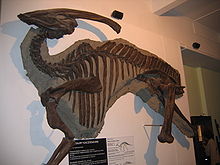- Lambeosaurinae
-
Lambeosaurines
Temporal range: Late Cretaceous, 76–65.5 Ma
Skeleton of Parasaurolophus walkeri, Museum of Evolution Warsaw Scientific classification 
Kingdom: Animalia Phylum: Chordata Class: Reptilia Superorder: Dinosauria Order: †Ornithischia Suborder: †Ornithopoda Family: †Hadrosauridae Node: †Euhadrosauria Subfamily: †Lambeosaurinae
Parks, 1923Type species †Lambeosaurus lambei
Parks, 1923Subgroups Lambeosaurinae is a group of crested hadrosaurid dinosaurs.
Classification
Lambeosaurines have been split into Parasaurolophini (Parasaurolophus) and Corythosaurini (Corythosaurus, Hypacrosaurus, and Lambeosaurus).[1] Corythosaurini and Parasaurolophini as terms entered the formal literature in Evans and Reisz's 2007 redescription of Lambeosaurus magnicristatus. Corythosaurini was defined as all taxa more closely related to Corythosaurus casuarius than to Parasaurolophus walkeri, and Parasaurolophini as all those taxa closer to P. walkeri than to C. casuarius. In this study, Charonosaurus and Parasaurolophus are parasaurolophins, and Corythosaurus, Hypacrosaurus, Lambeosaurus, Nipponosaurus, and Olorotitan are corythosaurins.[2] However, later researchers pointed out that due to the rules of priority set forth by the ICZN, Any tribe containing Lambeosaurus is properly named Lambeosaurini, and that therfore the name "Corythosaurini" is a junior synonym.[3] The enigmatic genus Tsintaosaurus may form a clade in Lambeosaurine with Pararhabdodon and its probable synonym Koutalisaurus.[4]
Phylogeny
Hadrosauridae was first defined as a clade, by Forster in a 1997 abstract, as simply "Lambeosaurinae plus Hadrosaurinae and their most recent common ancestor." In 1998, Paul Sereno defined the clade Hadrosauridae as the most inclusive possible group containing Saurolophus (a well-known hadrosaurine) and Parasaurolophus (a well-known lambeosaurine), later emending the definition to include Hadrosaurus, the type genus of the family, which ICZN rules state must be included, despite its status as a nomen dubium. According to Horner et al. (2004), Sereno's definition would place a few other well-known hadrosaurs (such as Telmatosaurus and Bactrosaurus) outside the family, which led them to define the family to include Telmatosaurus by default. The following cladogram was recovered in a 2010 phylogenetic analysis by Prieto-Márquez.[5]
Lambeosaurinae Parasaurolophini Corythosaurini (=Lambeosaurini) References
- ^ Glut, Donald F. (1997). Dinosaurs: The Encyclopedia. Jefferson, North Carolina: McFarland & Co. p. 69. ISBN 0-89950-917-7.
- ^ Evans, David C.; and Reisz, Robert R. (2007). "Anatomy and relationships of Lambeosaurus magnicristatus, a crested hadrosaurid dinosaur (Ornithischia) from the Dinosaur Park Formation, Alberta". Journal of Vertebrate Paleontology 27 (2): 373–393. doi:10.1671/0272-4634(2007)27[373:AAROLM]2.0.CO;2.
- ^ Sullivan, R., Jasinsky, S.E., Guenther, M. and Lucas, S.G. (2009). "The first lambeosaurin (Dinosauria, Hadrosauridae, Lambeosaurinae) from the Upper Cretaceous Ojo Alamo Formation (Naashoibito Member), San Juan Basin, New Mexico." New Mexico Museum of Natural History and Science Bulletin, 53: 405-417. [1]
- ^ Prieto-Márquez, A.; and Wagner, J.R. (2009). "Pararhabdodon isonensis and Tsintaosaurus spinorhinus: a new clade of lambeosaurine hadrosaurids from Eurasia". Cretaceous Research online preprint (5): 1238. doi:10.1016/j.cretres.2009.06.005.
- ^ Prieto-Márquez, A. (2010). "Global phylogeny of Hadrosauridae (Dinosauria: Ornithopoda) using parsimony and Bayesian methods." Zoological Journal of the Linnean Society, 159: 435–502.
Categories:- Hadrosaurs
Wikimedia Foundation. 2010.
